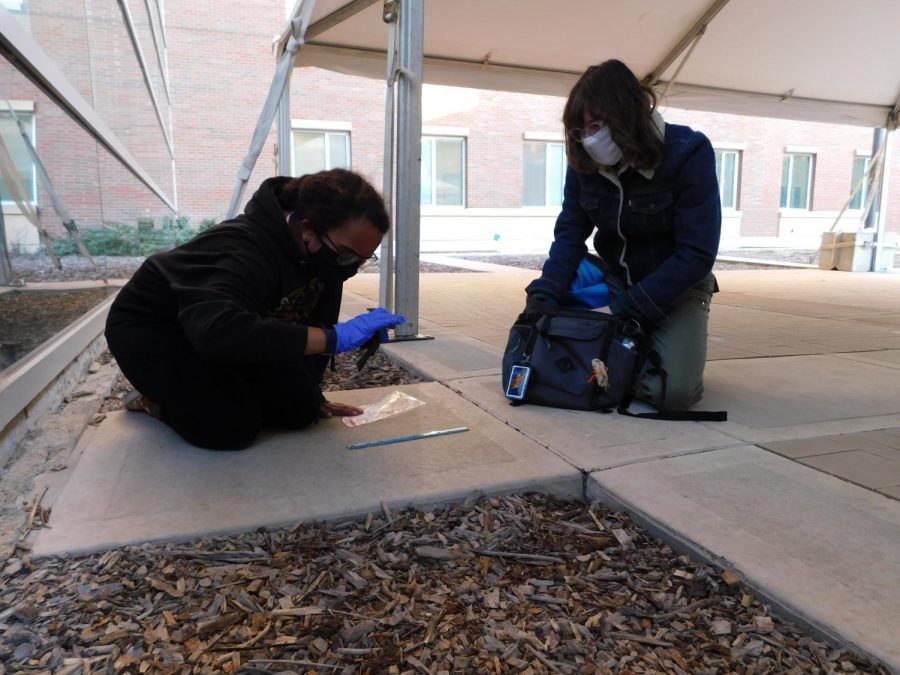UI Wildlife Society petitions for bird-safe campus architecture
Photo Courtesy of The Wildlife Society UIUC
The Wildlife Society UIUC student chapter Vice President Izabelle Jaquet (left) and chapter President Emmarie Alexander (right) participate in the bird collection survey.
January 28, 2021
Earlier this year, Emmarie Alexander, junior in ACES, sat at her desk in her room in her second-floor apartment, taking one of her Zoom classes. Alexander was startled by a loud noise, quickly turning her attention away from her class. She investigated the noise and realized a bird had collided with her window, now laid on the ground below.
Alexander has a passion for animals; she’s an animal science major and is the president of the University’s chapter of The Wildlife Society — a national organization dedicated to environmental stewardship and education. She brought up the incident with the bird and the window at a Wildlife Society meeting and learned about a group of graduate students who were surveying the amount of bird-window collisions on campus.
The bird that hit Alexander’s window was not an isolated incident, but rather indicative of a larger phenomenon across campus.
According to the survey, during the course of two three-week periods at the height of fall migration, more than 450 birds had died from colliding with buildings on campus.
To help combat this issue, the Wildlife Society has begun petitioning the University of Illinois System Board of Trustees to adopt bird-safe building measures. These measures include requiring all new buildings to feature glass that matches the standards of the American Bird Conservancy and to retrofit existing buildings to be bird-friendly. As of Jan. 26, the petition has 385 signatures.
Get The Daily Illini in your inbox!
The cost of implementing these measures is unclear and would vary depending on the size of the building and the method chosen to retrofit existing buildings.
The Wildlife Society has also reached out to the Illinois Student Government and the Student Sustainability Committee to help gain support for their cause. Additionally, the Purdue University chapter of the Wildlife Society has reached out to the Illinois chapter to ask for help campaigning the Purdue campus to implement bird-safe architecture policies.
Alec Luro, doctoral candidate in LAS, studies bird color and vision. Luro, along with Sarai Stuart and Rachel Skinner, both graduate students in LAS, led the campus bird window strike survey. As of November, the survey has found 489 birds that died due to building collisions on campus.
“(Birds have) evolved over millions and millions of years, but they never had to deal with glass before,” Luro said. “If you think about (the) Beckman Institute, where the windows are mirrored, they’re seeing trees. They’re not seeing a window, something to avoid, they’re seeing images of things they’d normally fly to.”
Beckman Institute, with its mirrored windows stationed behind a line of trees, has been the site of a startling number of bird collisions on campus. According to the bird window strike survey, 159 of the identified birds died after colliding with Beckman.
Other buildings that have been the major causes of bird death include Temple Hoyne Buell Hall with 43 recorded bird deaths, the Electrical and Computer Engineering Building with 37 bird deaths, and the Business Instructional Facility with 29 recorded bird deaths. Each building features extensive glass facades.
Part of the reason why so many birds collide with buildings on campus is due to the geographical location of Champaign-Urbana. Every fall, around late September to early October, billions of North American birds migrate south for the winter. One of the main migratory paths birds take, the Mississippi Flyway, passes right through Champaign-Urbana.
“Most people might see a bird hit a window and think ‘oh, that’s sad,’ but it’s happening everywhere every migration,” Luro said. “It’s a really terrible thing that’s happening, and I think it’s time people start thinking about it, especially the University. If we want to have a role as one of the leading institutions in the country, then we should try and have some exemplary conservation efforts as well.”
The issue of birds colliding into windows stretches far beyond campus. According to various studies, between 365 and 988 million birds die each year from colliding with man-made buildings — most often those with large, reflective windows.
Laura Whipple, graduate in ACES, is former president of the Illinois chapter of The Wildlife Society. Whipple took part in the bird window strike survey, scouring the campus for evidence of dead birds. While she is no longer a student, Whipple continues to support the group’s campaign to install bird-safe architecture.
“Birds are really important to the ecosystem,” Whipple said. “They’re a big part of the food chain, and we as people heavily depend on healthy environments, and birds are a really big part of that. We’re seeing a huge loss of bird diversity, and these window strikes are a really big part of that. There are millions and millions of birds flying over the school during peak migration. It’s kind of crazy, we’re really in the middle of a major migratory pathway, and it seems irresponsible to not address that problem.”







